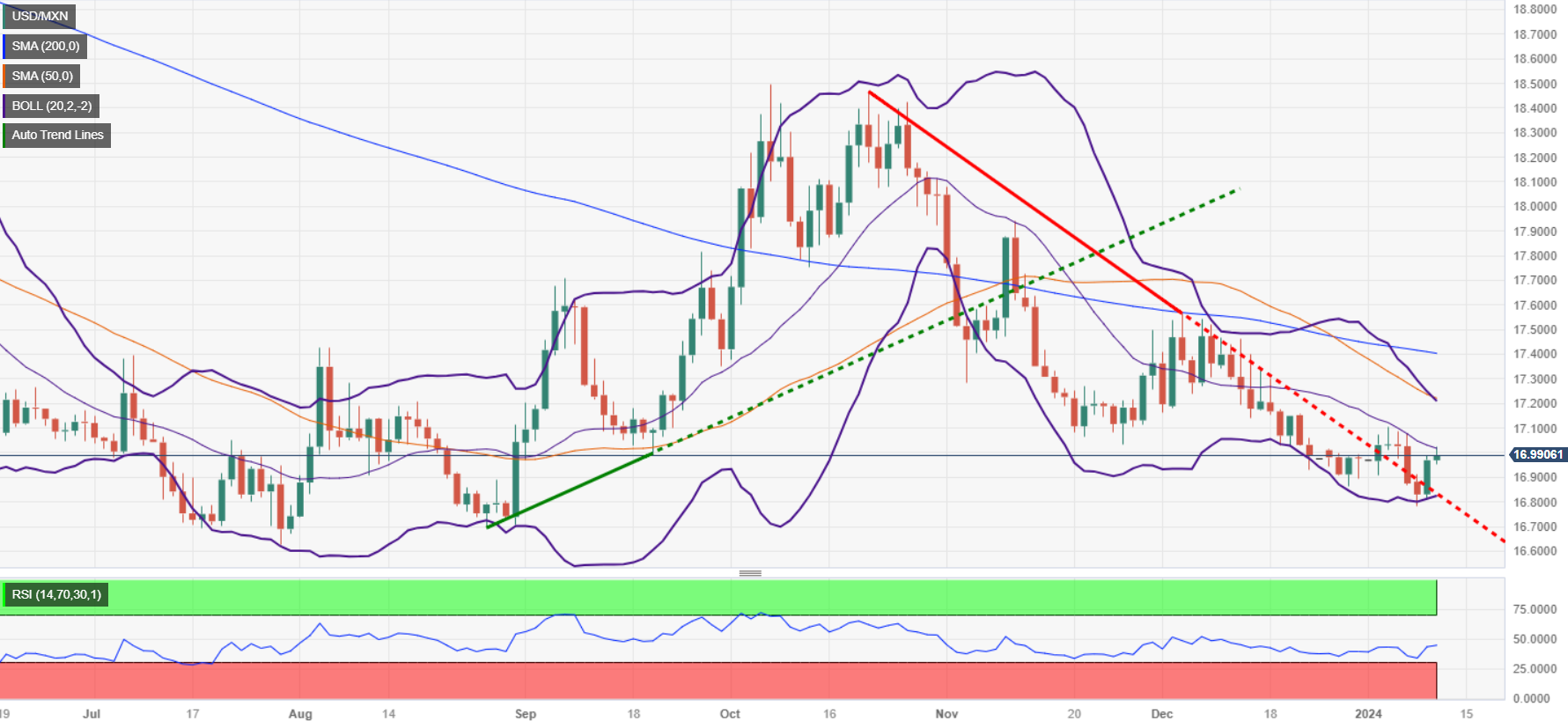- Mexican Peso registers loss of more than 0.30% on Wednesday amid risk-off impulse.
- Banxico’s potential rate cut for Q1 2024 in danger as Mexican inflation rises.
- World Bank’s revised GDP forecast for Mexico, predicting growth due to nearshoring, adds to the economic outlook for 2024
- USD/MXN traders prepare for Thursday’s US inflation data.
The Mexican Peso (MXN) extended its losses for two straight days against the US Dollar (USD) during the North American session as USD/MXN buyers stepped in and lifted the exchange rate past 17.00 to reach a daily high of 17.02. At the time of writing, the exotic pair is trading at 16.99, gaining 0.32%.
Mexico’s economic docket remains scarce, though it revealed that Gross Fixed Investment improved in October. The latest inflation report in Mexico was mixed as core inflation cooled while headline inflation advanced. Given the fact that two Bank of Mexico (Banxico) officials expressed their intentions of easing policy toward the end of Q1 2024, prices remain elevated, which might deter Banxico from cutting rates.
Aside from this, the World Bank updated its economic forecasts for Mexico in 2024. The World Bank expects the Gross Domestic Product (GDP) to rise toward 2.6% from 1.9% initially foresaw by the bank. Analysts at the bank expect the economy to grow amid increasing nearshoring activity.
Daily digest market movers: Mexican Peso gives way against US Dollar amid mixed Mexican data
- Mexico’s Gross Fixed Income rose 1.9% MoM in October, exceeding September’s -1.5% plunge, while annually-based figures exceeded forecasts of 22.8%, coming at 25.5%.
- The economy in Mexico is facing several challenges as inflation data was mixed alongside consumer confidence showing signs of deterioration. Elevated prices and a deceleration in economic growth could weigh on the Mexican Peso and cause its depreciation.
- Even though the latest Banxico meeting minutes indicate the central bank might consider easing policy, December’s inflation report might prevent the central bank from relaxing policy.
- On Tuesday, Mexico’s Consumer Price Index (CPI) rose by 4.66% YoY in December, exceeding forecasts of 4.55%.November’s print was 4.32%. Core figures came at 5.09% YoY, less than the consensus, and the previous month’s 5.15% and 5.30%, respectively.
- Consumer Confidence in Mexico deteriorated in December as households remained concerned about the future economic outlook.
- On January 5, a Reuters Poll suggested the Mexican Peso could weaken 5.4% to 18.00 per US Dollar in 12 months from December.
- Federal Reserve officials expressed that interest rates should remain at current levels. Fed’s Bostic emphasized that policy needs to stay tight, while Fed’s Bowman added that policy is sufficiently restrictive.
- The US economy continues to paint a mixed economic outlook as the latest US jobs data was mixed, while business activity in manufacturing contracted and the service sector deteriorated. Although a soft-landing scenario looms, the chance of a mild recession has increased, so caution is warranted.
Technical analysis: Mexican Peso is on the backfoot after reaching a three-day high above 17.00
The USD/MXN remains bearishly biased, though it briefly tested the 17.00 figure but was quickly rejected. The spot price is aimed toward the 16.97 area. If buyers achieve a daily close above the latest cycle low seen on November 27 at around 17.03, that could open the door for further gains. On further strength, the pair could test the 17.20 mark, followed by the 50-day Simple Moving Average (SMA) at 17.24, ahead of challenging the confluence of the 100 and 200-day SMAs at around 17.40
On the other hand, If sellers prevent the exotic pair from piercing the 17.00 figure, a test of last year’s low is on the cards. But sellers must conquer the 16.80 area, followed by the August 28 swing low of 16.69 ahead of the 2023 low of 16.62.
USD/MXN Price Action – Daily Chart
Risk sentiment FAQs
In the world of financial jargon the two widely used terms “risk-on” and “risk off” refer to the level of risk that investors are willing to stomach during the period referenced. In a “risk-on” market, investors are optimistic about the future and more willing to buy risky assets. In a “risk-off” market investors start to ‘play it safe’ because they are worried about the future, and therefore buy less risky assets that are more certain of bringing a return, even if it is relatively modest.
Typically, during periods of “risk-on”, stock markets will rise, most commodities – except Gold – will also gain in value, since they benefit from a positive growth outlook. The currencies of nations that are heavy commodity exporters strengthen because of increased demand, and Cryptocurrencies rise. In a “risk-off” market, Bonds go up – especially major government Bonds – Gold shines, and safe-haven currencies such as the Japanese Yen, Swiss Franc and US Dollar all benefit.
The Australian Dollar (AUD), the Canadian Dollar (CAD), the New Zealand Dollar (NZD) and minor FX like the Ruble (RUB) and the South African Rand (ZAR), all tend to rise in markets that are “risk-on”. This is because the economies of these currencies are heavily reliant on commodity exports for growth, and commodities tend to rise in price during risk-on periods. This is because investors foresee greater demand for raw materials in the future due to heightened economic activity.
The major currencies that tend to rise during periods of “risk-off” are the US Dollar (USD), the Japanese Yen (JPY) and the Swiss Franc (CHF). The US Dollar, because it is the world’s reserve currency, and because in times of crisis investors buy US government debt, which is seen as safe because the largest economy in the world is unlikely to default. The Yen, from increased demand for Japanese government bonds, because a high proportion are held by domestic investors who are unlikely to dump them – even in a crisis. The Swiss Franc, because strict Swiss banking laws offer investors enhanced capital protection.
Source: https://www.fxstreet.com/news/mexican-peso-softens-hitting-three-day-low-against-the-us-dollar-202401101702
